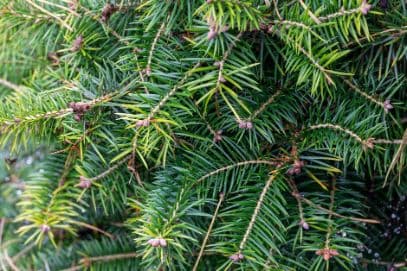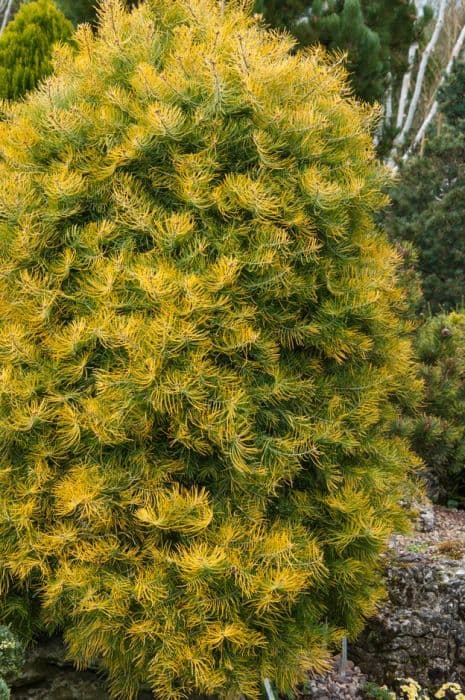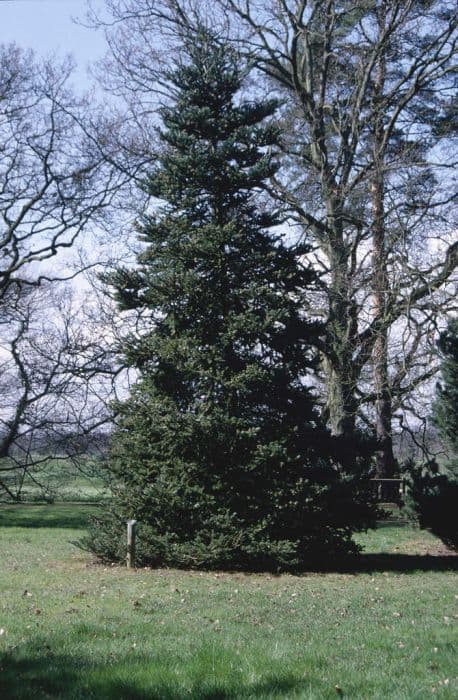Corkbark Fir Abies lasiocarpa var. arizonica 'Compacta' Hornibr.

ABOUT
The Compacta Arizona Corkbark Fir is a beautifully structured evergreen conifer, known for its distinctive, dense, and tightly packed foliage. It boasts a very symmetrical conical shape that gives it a neat and uniform appearance. The branches grow horizontally out from the central trunk, creating tightly layered rings of needles, which gives the plant a full and lush look. The needles themselves are a true spectacle; they are soft to the touch, unlike the sharp needles of many other conifers. Each needle is a lovely bluish-green color, adding a cool hue to the landscape. The rich color is not only soothing to the eyes but also provides a perfect backdrop for the contrasting brownish-red cones that occasionally adorn the tree. The bark of the Compacta Arizona Corkbark Fir is another notable feature; it has a unique cork-like texture that is fascinating to touch and provides interesting visual depth to the overall aesthetic of the plant. This particular variety is appreciated for its attractive visual quality, making it a popular choice among gardeners and landscapers looking to add evergreen interest to their gardens without worrying about excessive growth. Its aesthetic qualities, especially its color, texture, and form, make it stand out amongst its peers as a prime specimen for ornamental purposes.
About this plant
 Names
NamesFamily
Pinaceae.
Synonyms
Corkbark Fir, Compact Arizona Fir, Dwarf Corkbark Fir, Compact White Fir, Dwarf Arizona Fir.
Common names
Abies lasiocarpa var. arizonica.
 Toxicity
ToxicityTo humans
The plant known commonly as the Corkbark Fir typically does not contain toxins that are harmful to humans. There is no widely recognized concern regarding its toxicity for human ingestion. However, as with any non-food plant, it is generally recommended not to ingest parts of it since its effects are not well studied and individual reactions can vary.
To pets
The Corkbark Fir is similarly not known to be toxic to pets. These trees are not associated with poisonings in household pets such as dogs and cats. However, ingestion of non-food plants can potentially cause gastrointestinal discomfort or an obstruction; therefore, it is still wise to prevent pets from chewing on or consuming parts of this plant.
 Characteristics
CharacteristicsLife cycle
Perennials
Foliage type
Evergreen
Color of leaves
Green
Height
6 feet (1.83 meters)
Spread
4 feet (1.22 meters)
Plant type
Tree
Hardiness zones
4
Native area
North America
Benefits
 General Benefits
General Benefits- Aesthetic Appeal: Adds visual interest to gardens with its compact, dense growth and attractive blue-green foliage.
- Low Maintenance: Requires minimal pruning and upkeep compared to many other ornamental plants.
- Cold Tolerant: Resistant to harsh winter conditions, making it suitable for cooler climates.
- Drought Resistance: Once established, it is relatively drought-tolerant, reducing the need for frequent watering.
- Wildlife Habitat: Provides shelter and nesting sites for birds and other small wildlife.
- Adaptability: Capable of growing in a variety of soil types, provided they are well-drained.
- Slow Growing: Its slow growth rate makes it ideal for small gardens where space is limited.
- Erosion Control: The root system can help stabilize slopes and prevent soil erosion.
- Non-Invasive: Unlike some ornamental plants, it does not spread aggressively and is easy to control.
- Seasonal Interest: Offers year-round beauty, particularly in winter when other plants may be dormant.
 Medical Properties
Medical PropertiesThis plant is not used for medical purposes.
 Air-purifying Qualities
Air-purifying QualitiesThis plant is not specifically known for air purifying qualities.
 Other Uses
Other Uses- Miniature Christmas Tree: The 'Compacta' variety's small size and symmetrical shape make it ideal for use as a living Christmas tree in small spaces.
- Bonsai: This cultivar can be cultivated as a bonsai, providing an interesting challenge for enthusiasts of this Japanese art form.
- Photography Backdrop: Its dense foliage and attractive form can serve as a natural backdrop for outdoor photography and nature portraits.
- Sound Barrier: When planted in groups, Abies lasiocarpa 'Compacta' can create a sound-absorbing barrier in gardens near busy streets or noisy areas.
- Windbreak: Its dense branches can act as a windbreak, protecting smaller plants in the garden from harsh winds.
- Habitat for Wildlife: The branches of the 'Compacta' variety can provide nesting sites and shelter for birds and small mammals.
- Theme Gardens: This plant is suitable for creating alpine or woodland garden themes due to its natural growing environment and appearance.
- Educational Tool: Can be used in educational settings to demonstrate conifer growth patterns and cold-weather plant adaptations.
- Container Gardening: Suitable for container gardening for those who want evergreens on patios or balconies where ground planting is not an option.
- Festive Wreaths: Branch clippings can be used to create handmade wreaths and other holiday decorations.
Interesting Facts
 Feng Shui
Feng ShuiThe Corkbark Fir is not used in Feng Shui practice.
 Zodiac Sign Compitability
Zodiac Sign CompitabilityThe Corkbark Fir is not used in astrology practice.
 Plant Symbolism
Plant Symbolism- Endurance and Longevity: As a variety of fir tree, Abies lasiocarpa var. arizonica 'Compacta', commonly known as the Corkbark Fir, often symbolizes endurance because of its ability to survive in harsh climates and maintain its lush appearance year-round.
- Purity: The Corkbark Fir can also represent purity owing to its clean fragrance and the pristine natural environments it often inhabits, signifying a connection to unspoiled and pure natural elements.
- Resilience: This plant's ability to withstand cold temperatures and grow in poor soil conditions speaks to its symbolic meaning of resilience and the capability to overcome adversity.
- Growth and Stability: The strong, upright growth habit of the Corkbark Fir exemplifies stability and upward growth, making it a symbol for steady development and reliability.
 Water
WaterFor the Corkbark Fir, water deeply and infrequently to mimic natural conditions, aiming for about 1 to 1.5 inches of water per week during the growing season. In the absence of rain, this typically translates to watering every 7 to 10 days, using approximately 5 gallons for a young tree, scaling up for larger, established trees. Adjust the amount during heat waves or droughts, ensuring the water penetrates the soil to reach the tree's root system. During winter, reduce watering since the tree requires less moisture due to dormancy and cooler temperatures.
 Light
LightThe Corkbark Fir thrives in full sun to partial shade. It is most successful when planted in a location where it can receive at least six hours of direct sunlight daily. This evergreen prefers sites that avoid the intense heat of late afternoon in hot climates, which means an eastern or northeastern exposure can be ideal to prevent summer stress.
 Temperature
TemperatureCorkbark Fir is cold-hardy and flourishes in temperatures that range from -40 to 60 degrees Fahrenheit. The ideal growing conditions for this tree are within USDA zones 3 to 7. It can manage brief periods of warmer temperatures, but prolonged exposure above 80 degrees Fahrenheit may stress the plant.
 Pruning
PruningPruning the Corkbark Fir is generally limited to removing dead or damaged branches and can be done in late winter or early spring before new growth starts. Formal pruning is rarely needed due to its slow growth and compact habit. Any shaping or size control should also be done at this time to ensure the plant's natural form is maintained.
 Cleaning
CleaningAs needed
 Soil
SoilThe best soil mix for the Corkbark Fir is well-draining, sandy loam with good organic content. The ideal soil pH for Corkbark Fir is slightly acidic, ranging between 5.5 and 6.5. To prepare the soil mix, combine equal parts sand, loam, and organic matter like peat moss or compost.
 Repotting
RepottingCorkbark Fir does not typically require frequent repotting; it should only be repotted every few years as it is a slow-growing conifer. This plant may not need repotting until it outgrows its container or the soil becomes compacted.
 Humidity & Misting
Humidity & MistingCorkbark Fir prefers moderate humidity levels but is adaptable to the typical range found in many outdoor environments. It does not have high humidity needs, allowing it to thrive in average conditions without the need for misting or additional humidity measures.
 Suitable locations
Suitable locationsIndoor
Provide bright light, cool temps, and avoid dry heat.
Outdoor
Plant in full sun, well-drained soil; shelter from harsh winds.
Hardiness zone
4-7 USDA
 Life cycle
Life cycleAbies lasiocarpa var. arizonica 'Compacta', commonly known as the compact Arizona fir, begins its life cycle as a seed that germinates in moist, cool soil conditions, typically in the spring. The seedling stage follows, where the plant establishes a root system and begins photosynthesis. As the plant grows into a sapling and then matures, it develops a conical shape typical of many fir species, with denser, more compact growth due to its 'Compacta' cultivar characteristics. During its mature phase, the compact Arizona fir produces cones that are pollinated by the wind, leading to seed development and dispersal. Throughout its life, the Arizona fir undergoes seasonal changes, with slower growth in winter and more vigorous growth in warmer months. This fir can live for many years, slowly increasing in height and girth until it reaches its full mature size or is affected by environmental factors such as drought, pests, or disease which may lead to its decline and eventual end of life.
 Propogation
PropogationPropogation time
Spring-Early Summer
Propogation: The Corkbark Fir is best propagated through semi-hardwood cuttings, which is generally the most popular method. This involves taking a cutting from a healthy parent plant during the summer months when the current year's growth has begun to mature but is not fully hardened, typically around mid-July to early August. Cut a 4 to 6 inch (10 to 15 cm) section of stem, removing the lower needles to expose the nodes and applying a rooting hormone to the cut end can improve chances of success. The cutting should be planted in a well-draining soil mix and kept in a humid environment until roots have established, which can take several weeks. Constant moisture and indirect sunlight are crucial during this rooting phase to ensure a healthy, new Corkbark Fir sapling.









